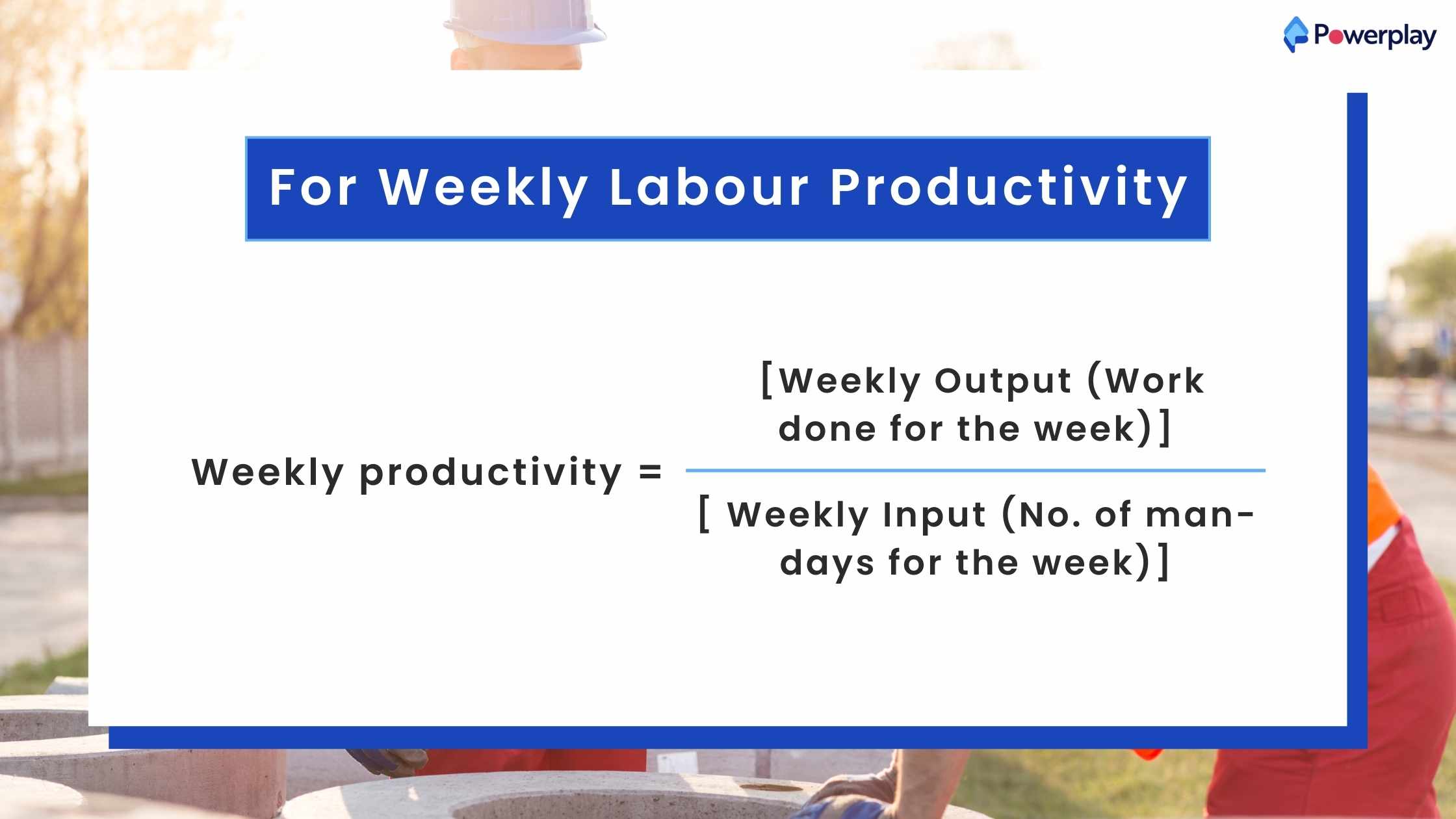How to Measure and Improve Labour Productivity in Construction?
-
Kumar Abhishek Anand
- March 21, 2023

The measurement of the productivity of construction workers can be a challenging task. Contrary to manufacturing and other industries, construction jobs are largely influenced according to the type of project, contractor specialisation, and other elements. In other words, measuring efficiency is more challenging if you’re not mass-producing a standard product.
Despite these obstacles, industry researchers and experts have made progress in measuring productivity over the past few years. Some intriguing developments have been observed. Although exact metrics for productivity vary, most sources agree that construction productivity could be improved.
Table of Contents
ToggleWHAT IS LABOUR PRODUCTIVITY IN CONSTRUCTION?
Labour productivity in construction means how your labour working time relates to the effort to complete work on the project site. In general, it means the amount of work done per labour hour. More work done in less time means high productivity which directly leads to many benefits for your construction project and business at large.

HOW DO YOU MEASURE LABOUR PRODUCTIVITY?
The most straightforward method of calculating productivity in the workplace involves dividing the output in half by input. The output is the work performed by labourers, like shuttering, cutting and bending rebars, concrete pouring work, and so on.
Labour productivity = [Output (Total Work done)] / [Input (Total No. of Man days Consumed)]
The calculation of labour productivity using the formula above is for the entire job. However, the daily, weekly, and monthly productivity could be calculated by changing the formula for labour productivity accordingly. The following formulae illustrate the labour productivity formula that calculates weekly and daily productivity.
1. For Daily Labour Productivity,
Daily Productivity = [Daily Output (Work done for the day)] / [Daily Input (No. of labourers on the job for that day)]

2. For Weekly Labour Productivity,
Weekly Productivity = [Weekly Output (Work done for the week)] / [ Weekly Input (No. of man-days for the week)]

WHY IS LABOUR PRODUCTIVITY IMPORTANT?

For you to have a healthy and profitable business, your labour productivity must be high all the time. Let us know why:
- Reduced Project Costs: Labour is one of the most significant cost factors in the construction industry. Better labour productivity in construction means lesser labour cost per unit of work done.
- On-time Project Completion: Completing more work in less time can ensure that your construction projects stay ahead of schedule and avoid costly delays
- Better Resource Management: When you understand your labour productivity, you can effectively allocate resources and manpower to different tasks.
FACTORS AFFECTING LABOUR PRODUCTIVITY IN CONSTRUCTION

Labour productivity in construction is influenced by several factors some of which are noted below:
- Workforce Skill and Experience: A skilled and experienced workforce can complete tasks more efficiently and effectively
- Project Planning and Scheduling: Poor planning with unclear timelines, material shortages, or inefficient task sequencing can significantly decline productivity
- Communication and Coordination: Effective communication between workers, supervisors, and different teams is essential for smooth workflow and avoiding delays
- Motivation and Incentives: Motivated workers with clear incentives are more likely to put in their best effort and achieve higher productivity levels
- Use of Technology and Equipment: Modern tools and equipment can automate repetitive tasks and improve worker efficiency
- Site Conditions and Weather: Unavoidable weather conditions or poorly managed construction sites can disrupt workflows and decrease productivity
By understanding these factors and implementing strategies to address them, construction companies can significantly improve labour productivity. This, in turn, leads to a more efficient, profitable, and competitive construction business.
HOW TO IMPROVE LABOUR PRODUCTIVITY IN CONSTRUCTION?
The plight of labourers working in the Indian construction industry is the worst compared to all other countries in the world. With all the various elements that impact productivity, how can contractors enhance their performance within these fields? Here are a few possibilities that are easy to recognise but worth trying:
1. Respecting Laborers for Increased Productivity
Labourers are not treated properly at construction sites in India. They feel discouraged to work productively. Just because they are labourers who work as daily wagers, does not mean that they do not deserve respect. They should be given their due as workers who are toiling every day to make a meagre living. Managers and engineers should interact more humanely with them so that they feel motivated and work more productively.
2. Well-being Through Breaks and Compensation

Proper breaks in between tasks should be allowed so that they get time to rest and can work with the same intensity throughout the day. They should be duly compensated for overtime.
3. Building a Skilled and Loyal Workforce
Most contractors are well aware of the need to employ a highly skilled workforce. However, finding and keeping skilled employees can be a struggle because of the constant character of the construction industry. Focusing on keeping employees and reducing turnover is one method to maintain and build a skilled workforce. If you treat employees respectfully, you’ll likely see people more motivated to complete good work and stay loyal to the company.
4. Safe Work Environment, and Proper Equipment

Beginning with bidding, look for projects suitable to your staff’s complexity and size. If you are working on active projects, ensure adequate access to the site a safe workplace and appropriate equipment.
Field equipment can include high-quality machines and tools, PPE (personal protective equipment) (PPE), and vehicles. At the site, labourers should feel safe while working.
5. Optimising Staff Size
Some indirect overhead or labour is essential to running a company, but determining the right size is essential to successfully running a business. Like it is crucial to have qualified field personnel, having a competent staff for accounting and bidding, human resources, and other administrative tasks is essential.
Small-scale business owners may have difficulty determining the appropriate proportion between delegating these duties and handling these tasks themselves. Other non-productivity activities, like the need to rework, can be reduced through proper training and dealing with prior issues related to workplace conditions and the labour force.
6. Weatherproofing Your Construction Project
The weather is clearly out of the contractor’s control. A proper plan can prevent the effects of this old foe. Be aware of your contract and any clauses that deal with the weather. If you can, include provisions that will help in severe weather conditions. Technologies, such as apps that track weather on mobile devices, can assist with project day-to-day and hourly control.
7. Professional and Employee-Friendly Work Environment
Similar to working conditions, you should run an organization that is sensitive to noise, ergonomics, work hours, compensation, and other elements. Simply put, create an environment that is professional for the business as a whole and also for employees on the individual level.
8. Modern Technology for Efficient Project Management

In addition to keeping high-quality machinery and equipment, ensure that you use the most current software to manage your business and projects. Ideally, you’ll need an application that allows project teams to work together and exchange information in real-time with field and office teams. Try to create a unified system that provides an efficient and consistent reporting system rather than a mix of techniques that rely heavily on spreadsheets, emails or handwritten notes.
HOW CAN POWERPLAY BOOST LABOUR PRODUCTIVITY IN CONSTRUCTION?

Powerplay is an end-to-end construction management app which helps construction businesses manage their labour, tasks, and materials. Tacking labour attendance and labour productivity is one of the key modules of Powerplay. It helps project managers to track the labourer’s working hours, overtime, and half-days, which helps them keep a better track and calculate their labourer payables. Construction owners get a clear picture of their labour expenses and thereby make better decisions faster. Powerplay is available on Android, iOS, and Web.
Real-Time Attendance Tracking
Real-time attendance tracking eliminates the need for manual records and simplifies payroll by providing instant updates on who’s clocked in, late, or absent. This allows you to see your current workforce at a glance, enabling you to make quick decisions and adjust resources as needed based on real-time staffing levels.
Workforce Allocation & Optimisation
By strategically assigning tasks based on individual skills, current availability, and the specific needs of each project, you can ensure the right people are working on the right things. This not only optimizes project efficiency but also avoids overloading specific teams or individuals, promoting a healthier work environment.
Payroll
By automatically feeding work hours data into payroll, you eliminate manual paperwork and the risk of errors, guaranteeing everyone receives the correct pay. This integrated system also helps monitor overtime, allowing you to stay within budget and adhere to labour regulations. With better visibility into workloads, you can optimize your team’s efforts by assigning tasks that match their skills and avoid overloading specific individuals or departments.
Share
Kumar is a digital content professional with more than 2 years of experience in Blog writing, copywriting and scripting. His passion lies in the art of creating convincing content that plays a major role in converting leads for SAAS businesses.












